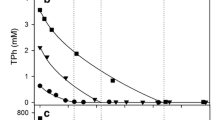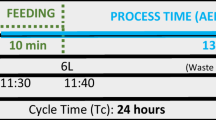Abstract
As a result of its wide usage in the production of polycarbonate plastics and epoxy resins, bisphenol A (BPA) is commonly detected in wastewaters. Recently, BPA became a major concern because its adverse effects as an endocrine disruptor. In this work, the biodegradation kinetics of BPA and its metabolic intermediates 4-hydroxyacetophenone (4HAP), 4-hydroxybenzaldehyde (4HB) and 4-hydroxybenzoic acid (4HBA) by BPA-acclimated activated sludge was studied using manometric respirometry (BOD) tests. For all the tested compounds, BOD curves exhibited two phases. In the first one, a fast increase of the oxygen consumption (OC) due to the active oxidation of the substrate was obtained. Then, when the substrate was exhausted, the endogenous respiration produced a slower increase of OC. A standard Monod-model with biomass growth was used to represent the OC profiles as a function of time. For all the tested compounds, a good agreement between the proposed model and the experimental data was obtained. According to their biodegradation rates, the tested compounds can be ordered as follows: BPA < 4HAP ≪ 4HB < 4HBA. Because the oxidation rate of BPA by BPA-acclimated activated sludge limits the rate of the whole biodegradation pathway, the accumulation of metabolic intermediates 4HAP, 4HB, and 4HBA would be negligible. To calculate the dissolved oxygen (DO) concentration (C) during the BOD tests, the oxygen transfer coefficient (kLa) of the BOD bottles was obtained using the sulfite method. Finally, a simple procedure to calculate the minimum DO concentration (Cmin) based on BOD data was developed. Calculation results demonstrated that under the tested conditions, C values were high enough as not to be the limiting substrate for the microbial growth.





Similar content being viewed by others
References
Braun JM, Yolton K, Dietrich KN, Hornung R, Ye X, Calafat AM, Lanphear BP (2009) Prenatal bisphenol A exposure and early childhood behavior. Environ Health Persp 117:1945–1952
Braun JM, Kalkbrenner AE, Calafat AM, Yolton K, Ye X, Dietrich KN, Lanphear BP (2011) Impact of early-life bisphenol A exposure on behavior and executive function in children. Pediatrics 128:873–882
Contreras EM (2008) Stoichiometry of sulfite oxidation by oxygen during the determination of the volumetric mass transfer coefficient. Ind Eng Chem Res 47:9709–9714
Ferro Orozco AM, Contreras EM, Zaritzky NE (2010) Dynamic response of combined activated sludge-powdered activated carbon batch systems. Chem Eng J 157:331–338
Ferro Orozco AM, Contreras EM, Zaritzky NE (2013) Biodegradation of bisphenol-A (BPA) in activated sludge batch reactors: analysis of the acclimation process. Int Biodet Biodeg 85:392–399
Ferro Orozco AM, Contreras EM, Zaritzky NE (2015) Simultaneous biodegradation of bisphenol A and a biogenic substrate in semi-continuous activated sludge reactors. Biodegradation 26:183–195
Ferro Orozco AM, Contreras EM, Zaritzky NE (2016) Biodegradation of bisphenol A and its metabolic intermediates by activated sludge: stoichiometry and kinetics analysis. Int Biodet Biodeg 106:1–9
Gao J, Ellis LBM, Wachett LP (2010) The University of Minnesota Biocatalysis/Biodegradation Database: improving public access. Nucleic Acids Res 38:488–491
Geens T, Goeyens L, Covaci A (2011) Are potencial sources for human exposure to Bisphenol A over looked? Int J Hyg Environ Health 214:339–347
Henze M, Gujer W, Mino T, Van Loosdrecht MV (2002) Activated sludge models ASM1, ASM2, ASM2d and ASM3. IWA Publishing, London
Keum YS, Lee HR, Park HW, Kim J-H (2010) Biodegradation of bisphenol A and its halogenated analogues by Cunninghamella elegans ATCC36112. Biodegradation 21:989–997
Lang IA, Galloway TS, Scarlett A (2008) Association of urinary bisphenol A concentration with medical disorders and laboratory abnormalities in adults. J Am Med Assoc 300:1303–1310
Li D, Zhou Z, Qing Y, He Y, Wu T, Miao M, Wang J, Weng X, Ferber JR, Herrinton LJ, Zhu Q, Gao E, Checkoway H, Yuan W (2010) Occupational exposure to bisphenol-A (BPA) and the risk of self-reported male sexual dysfunction. Human Reprod 25:519–527
Lobo CC, Bertola NC, Contreras EM (2013) Stoichiometry and kinetic of the aerobic oxidation of phenolic compounds by activated sludge. Bioresour Technol 136:58–65
Melcer H, Klecka G (2011) Treatment of wastewaters containing bisphenol A: state of the science review. Water Environ Res 83:650–666
Mendes P (1993) GEPASI: a software package for modelling the dynamics, steady states and control of biochemical and other systems. Comput Appl Biosci 9:563–571
Mendes P, Kell D (1998) Non-linear optimization of biochemical pathways: applications to metabolic engineering and parameter estimation. Bioinformatics 14:869–883
Miao M, Yuan W, Zhu G, He X, Li D-K (2011) In utero exposure to bisphenol-A and its effect on birth weight of offspring. Reprod Toxicol 32:64–68
Modaressi K, Taylor KE, Bewtra JK, Biswas N (2005) Laccase-catalyzed removal of bisphenol-A from water: protective effect of PEG on enzyme activity. Water Res 39:4309–4316
OECD Guidelines for testing of chemicals. Paris, 1993
OECD 4-hydroxybenzoic acid. OECD SIDS. UNEP publications, 1999
Omoike A, Wacker T, Navidonski M (2013) Biodegradation of bisphenol A by Heliscus lugdunensis, a naturally occurring hyphomycete in freshwater environment. Chemosphere 91:1643–1647
Orhon D, Artan N (1994) Modeling of activated sludge systems. Technomic, Basel
Peng Y-H, Chen Y-J, Chang Y-J, Shih Y-H (2015) Biodegradation of bisphenol A with diverse microorganisms from river sediment. J Hazard Mater 286:285–290
Plastics Europe, 2010. The plastics portal. Extracted from: http://www.plasticseurope.org/
Rees-Clayton EM, Todd M, Dowd JB, Aiello AE (2011) The impact of bisphenol A and triclosan on immune parameters in the U.S. population, NHANES 2003-2006. Environ Health Persp 119:390–396
Reuschenbach P, Pagga U, Strotmann U (2003) A critical comparison of respirometric biodegradation tests based on OECD 301 and related test methods. Water Res 37:1571–1582
Sakai K, Yamanaka H, Moriyoshi K, Ohmoto T, Ohe T (2007) Biodegradation of bisphenol A and related compounds by Sphingomonas sp. strain BP-7 isolated from seawater. Biosci Biotechnol Biochem 71:51–57
Salian S, Doshi T, Vanage G (2009) Perinatal exposure of rats to Bisphenol A affects the fertility of male offspring. Life Sci 85:742–752
Sander R (2015) Compilation of Henry’s law constants (version 4.0) for water as solvent. Atmos Chem Phys 15:4399–4981
Sasaki M, Maki J-I, Oshiman K-I, Matsumura Y, Tsuchido T (2005) Biodegradation of bisphenol A by cells and cell lysate from Sphingomonas sp. strain AO1. Biodegradation 16:449–459
Simkins S, Alexander M (1984) Models for mineralization kinetics with the variables of substrate concentration and population density. Appl Environ Microbiol 47:1299–1306
Simkins S, Alexander M (1985) Nonlinear estimation of the parameters of monod kinetics that best describe mineralization of several substrate concentrations by dissimilar bacterial densities. Appl Environ Microbiol 50:816–824
Spivack J, Leib TK, Lobos JH (1994) Novel pathway for bacterial metabolism of bisphenol A. rearrangements and stilbene cleavage in bisphenol A metabolism. J Biol Chem 269:7323–7329
Staples CA, Dorn PB, Klecka GM, O’Block ST, Harris LR (1998) A review of the environmental fate, effects, and exposures of bisphenol A. Chemosphere 36:2149–2173
Stasinakis AS, Petalas AV, Mamais D, Thomaidis NS (2008) Application of the OECD 301F respirometric test for the biodegradability assessment of various potential endocrine disrupting chemicals. Biores Technol 99:3458–3467
Sugiura-Ogasawara M, Ozaki S, Sonta Y, Makino T, Suzumori K (2005) Exposure to bisphenol A is associated with recurrent miscarriage. Human Reprod 20:2325–2429
Wang L, Zhao J, Li Y (2014) Removal of bisphenol A and 4-n-nonylphenol coupled to nitrate reduction using acclimated activated sludge under anaerobic conditions. J Chem Technol Biotechnol 89:391–400
Wei J, Lin Y, Li Y, Ying C, Chen J, Song L, Xu S (2011) Perinatal exposure to bisphenol A at reference dose predisposes offspring to metabolic syndrome in adult rats on a high-fat diet. Endocrinology 152:3049–3061
West RJ, Goodwin PA, Klecka GM (2001) Assessment of the ready biodegradability of bisphenol A. Bull Environ Contam Toxicol 67:106–112
Wolstenholme, J.T., Taylor, J.A., Shetty, S.R.J., Edwards, M., Connelly, J.J., Rissman, E.F., 2011. Gestational Exposure to Low Dose Bisphenol A Alters Social Behavior in Juvenile Mice. PLOS ONE 6(9)e25448. doi:10.1371/journal.pone.0025448
Xiaoying M, Guangming Z, Chang Z, Zisong W, Jian Y, Jianbing Li, Guohe H, Hongliang L (2009) Characteristics of BPA removal from water by PACl-Al13 in coagulation process. J Colloid and Interface Science 337:408–413
Zeng G, Zhang C, Huang G, Yu J, Wang Q, Li J, Xi B, Liu H (2006) Adsorption behavior of bisphenol A on sediments in Xiangjiang River, Central-south China. Chemosphere 65:1490–1499
Zhang C, Zeng G, Yuan L, Yu J, Li J, Huang G, Xi B, Liu H (2007) Aerobic degradation of bisphenol A by Achromobacter xylosoxidans strain B-16 isolated from compost leachate of municipal solid waste. Chemosphere 68:181–190
Author information
Authors and Affiliations
Corresponding author
Electronic supplementary material
Below is the link to the electronic supplementary material.
Rights and permissions
About this article
Cite this article
Ferro Orozco, A.M., Contreras, E.M. & Zaritzky, N.E. Monitoring the biodegradability of bisphenol A and its metabolic intermediates by manometric respirometry tests. Biodegradation 27, 209–221 (2016). https://doi.org/10.1007/s10532-016-9767-4
Received:
Accepted:
Published:
Issue Date:
DOI: https://doi.org/10.1007/s10532-016-9767-4




